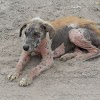LSD was first reported in zimbia in 1929, and it subsequently spread to south Africa to Egypt to india and now first time seen in Nepal. LSD is not Zoonotic.
ETIOLOGY:
The caused of this disease is related to sheep pox and goat pox of family pox viridae. Genus capripoxvirus. And have a double standard DNA genome. LSD appear epidemically or sporadically. Its incident is highest in wet summer weather, but it may occur in winter.
SPREAD:
LSD is transmitted through direct contact between
infected and non infected animal. The principle means of transmission is
believed to be arthropod vector. Through no specific vector has been identified
to date. Mosquitoes, biting flies, and ticks could play a significant role in
transmission of this virus.
Cattle of all breed, including wild animal are susceptible
CLINICAl SIGN AND SYMPTOMS:
LSD sign can be sub clinical or clinical. Incubation period is 4 to 14 days. Mortality
is usually low and morbidity is 5 to 50 %.
Clinical sign include, fever, pneumonia, skin nodules, that’s cover entire animal body, nodule are round, raised and painful, nodules contain a frim, creamy gray or yellow mass tissue. And they involved in the cutaneous skin. Nodules either regress or necrosis of the skin result in hard, raised area clearly separated from surrounding skin.
Nodules are also present in genital tract, muzzle, nasal cavity, udder, teats, respiratory tract. Edema develops on the leg and brisket region with lameness and regional lymphnode become enlarged, and secondary infection occurs.
DIAGNOSIS:
Clinical
sign, history, PCR test is also done for diagnosis of this disease. The
diagnosis may be confusing with pseudo lumpy skin disease which is caused by
herpes virus. There are other disease which is confusing with LSD are cutaneous
tuberculosis, insect or ticks bite, papillomatosis, demodecosis etc… but
differentiation depends essentially on isolation and identification of virus.
Dermatophilus congolensis
also caused skin nodules in cattle.
TREATMENT AND PREVENTION:
There is no specific treatment for this disease. The only treatment available is supportive care of cattle. Administration of antibiotics to control secondary infection and good nursing care are recommended. Vaccination is the most promising method of control.
Movement control (quarantine), management strageties. Sick animal should be kept well apart from the rest of herd and most not share drinking or feeding troughs. Animal older than 6 month must be vaccinated against LSDV. It is safe to vaccinate pregnant cattle. All animal must be vaccinated once
Manoj karki (BVSC&AH)








0 Comments